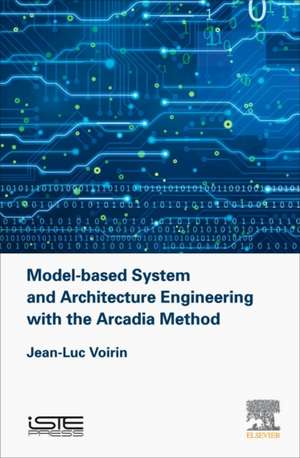Model-based System and Architecture Engineering with the Arcadia Method
Autor Jean-Luc Voirinen Limba Engleză Hardback – 22 noi 2017
This book describes the fundamentals of the method and its contribution to engineering issues such as requirements management, product line, system supervision, and integration, verification and validation (IVV). It provides a reference for the modeling language defined by Arcadia.
The author discusses the range of applications, from the assessment of different architectures and their suitability, to the collaboration between system engineering, specialties such as safety or security, subsystems engineering teams, software and hardware. This is illustrated by several examples of representative models which constitute a common thread.
- Offers a comprehensive examination of systems engineering, including the use of models to support it
- Not only yet another book on modeling, but rather a journey in systems engineering, enlightening the use of models to support it.
- Focuses on solitary modeling tasks while also covering prime collaborations between engineering stakeholders
- Examines modeling techniques to capture and share architecture and to early verify it against need and non-functional constraints
- Addresses subjects not usually covered by model-based system engineering (MBSE) methods, such as co-engineering with specialties, system/sub-system co-engineering, integration verification and validation
- Features a powerful, dedicated tool (Capella)
- Covers a range of topics, including an introduction to system engineering issues, an introduction to MBSE, a presentation of the method for beginners and a handy reference manual for advanced users
Preț: 732.26 lei
Preț vechi: 1087.91 lei
-33% Nou
Puncte Express: 1098
Preț estimativ în valută:
140.14€ • 144.77$ • 116.63£
140.14€ • 144.77$ • 116.63£
Carte tipărită la comandă
Livrare economică 19 martie-02 aprilie
Livrare express 18-22 februarie pentru 180.53 lei
Preluare comenzi: 021 569.72.76
Specificații
ISBN-13: 9781785481697
ISBN-10: 178548169X
Pagini: 388
Dimensiuni: 152 x 229 x 27 mm
Greutate: 0.76 kg
Editura: ELSEVIER SCIENCE
ISBN-10: 178548169X
Pagini: 388
Dimensiuni: 152 x 229 x 27 mm
Greutate: 0.76 kg
Editura: ELSEVIER SCIENCE
Cuprins
Part 1. Foundations of the Method: General Approach and Major Prospects
1. Motivations, Background and Introduction to Arcadia
2. Main Perspectives Structuring the Modeling Approach
3. Adaptation to Project Context and Life Cycle
4. General Approach to Functional Analysis
5. Operational Analysis
6. System Needs Analysis
7. Definition of the Principle Architecture or Logical Architecture
8. Definition of the Finalized Architecture or Physical Architecture
9. Definition of Implementation, Development,Acquisition and Integration Contracts
Part 2. Method in Action: Using Engineering Models
10. Mixing Viewpoints: Analysis and Specialties
11. Requirements Engineering and Modeling
12. Integration, Verification and Validation Approach
13. Articulation between Engineering Levels
14. System Supervision, States and Modes
15. Contribution to Product Line Engineering
Part 3. Encyclopedia of the Language and Glossary of the Concepts of Arcadia
16. Introduction to Arcadia Modeling Language
17. Concepts of Functional and Operational Description
18. Concepts of States and Modes
19. Concepts of Structural Description
20. Links between Functional and Structural Descriptions
21. Data Exchange Concepts and Links with Functional and Structural Concepts
22. Additional Concepts
23. Building the Global Model
1. Motivations, Background and Introduction to Arcadia
2. Main Perspectives Structuring the Modeling Approach
3. Adaptation to Project Context and Life Cycle
4. General Approach to Functional Analysis
5. Operational Analysis
6. System Needs Analysis
7. Definition of the Principle Architecture or Logical Architecture
8. Definition of the Finalized Architecture or Physical Architecture
9. Definition of Implementation, Development,Acquisition and Integration Contracts
Part 2. Method in Action: Using Engineering Models
10. Mixing Viewpoints: Analysis and Specialties
11. Requirements Engineering and Modeling
12. Integration, Verification and Validation Approach
13. Articulation between Engineering Levels
14. System Supervision, States and Modes
15. Contribution to Product Line Engineering
Part 3. Encyclopedia of the Language and Glossary of the Concepts of Arcadia
16. Introduction to Arcadia Modeling Language
17. Concepts of Functional and Operational Description
18. Concepts of States and Modes
19. Concepts of Structural Description
20. Links between Functional and Structural Descriptions
21. Data Exchange Concepts and Links with Functional and Structural Concepts
22. Additional Concepts
23. Building the Global Model
